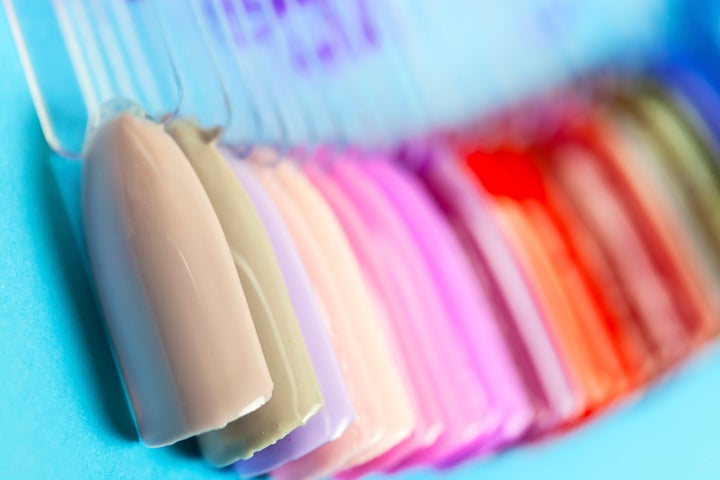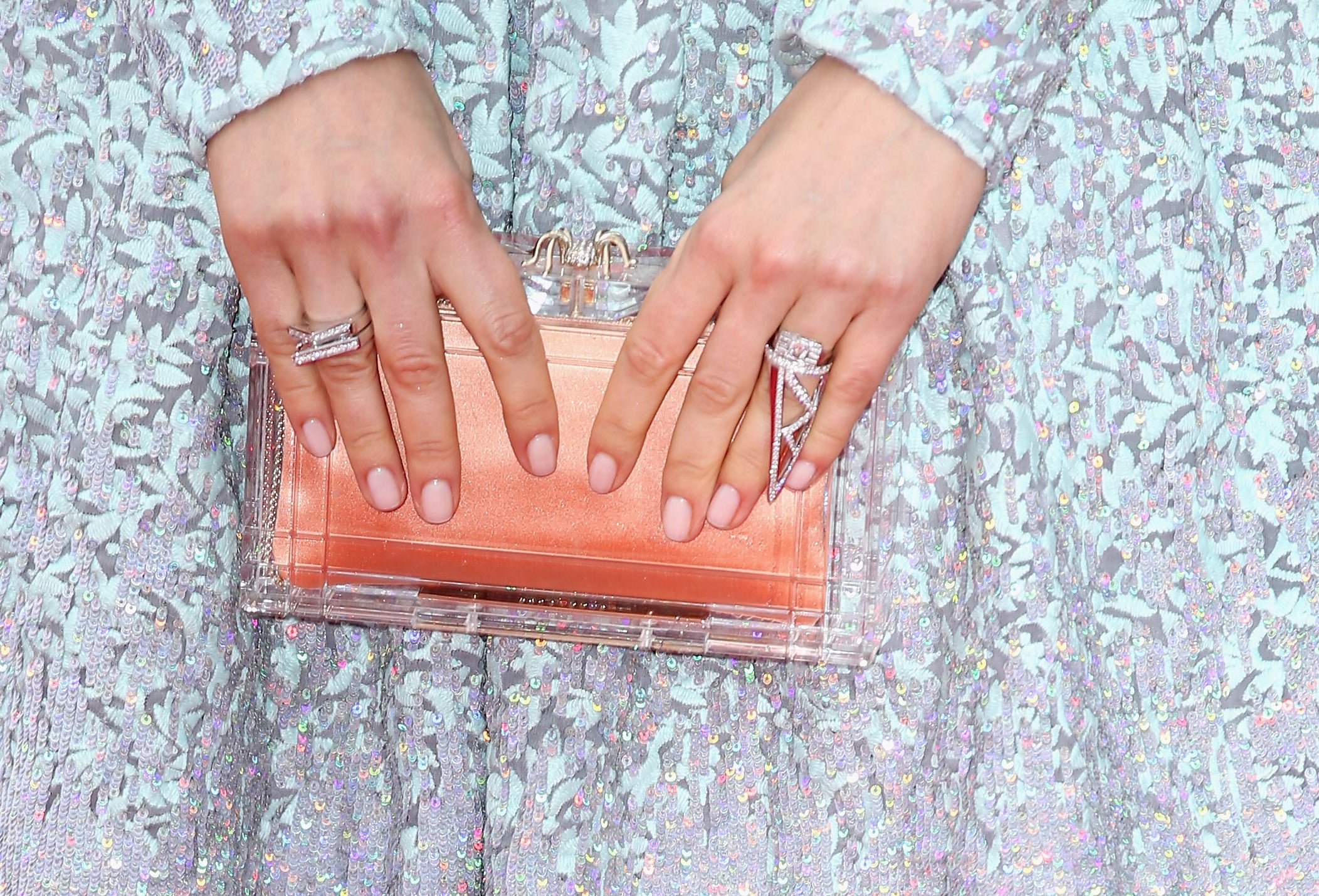If you’ve ever gone to the salon for a manicure, it’s likely you’ve experienced the frustration of smudging your polish before you even make it home, or having it chip ahead of the event for which you got your nails done, simply because of the wear and tear of daily life.
Powder dip manicures — one of Pinterest’s recent top trends — promise an enduring mani that won’t crack, and according to manicurist Anna Csetri of Future Nail Sisters salon in Manchester, England, the Instagrammable tips have overtaken gel manicures in their popularity with clients.
“Almost two years ago we started to do dip powder and nobody went back to the gel,” Cestri told HuffPost. “We still do gel as well, but mostly use the dip powder.”
So what are the pros and cons of powder gel vs. regular gel manicures? The experts broke it down for us.
+1 for powder dip: There’s no harmful UV light
Clients flock to powder dip manicures because they don’t require UV light to dry like traditional gel varieties, Csetri said.
While the UV light “isn’t a concern so much for [skin cancer under the nail] because light does not penetrate the nail very well,” said Shari Lipner, a dermatologist at Weill Cornell Medicine and New York-Presbyterian, “it is risky because you’re exposing the tops of your hands to UV light that over the long term could be very detrimental.” A study from the Journal of the American Academy of Dermatology found that during the gel manicure UV drying process, one’s hands take in an energy dose equal to the daylong recommended limit for outdoor workers.
+1 for gel: A longer-lasting mani can be damaging
Powder gels have garnered favor because of how long they stay pristine. “It doesn’t chip or break and it lasts longer than gel polish,” Csetri said. “It lasts about three, four or even five weeks.”
But Lipner pointed out that a manicure’s extreme longevity can actually be a detriment. “You’re covering up any problems that could be under the nail and it won’t give you time to check the nail,” she said.
+1 for gel: Dipping nails into powder can cause bacterial infection
“After clients wash their hands, I push up the cuticle and trim the dead skin,” Maryland nail technician and esthetician Kayla Nguyen explained of how she starts the process. “Then I clean the nails to remove excess oil so the dip will stick better. I’ll shave, put the base gel, and then dip the nail in the color the client chose. Very thin, two times. The last coat is the clear coat to protect the color and after the clear, I put on the activator to make the powder harden and dry. After that, I will shave a little bit. I use a very fine drill bit to smooth them around the cuticle.”

New York City dermatologist Michele Green said the initial pushing back of the cuticle in any manicure, gel or powder, could cause initis (inflammation of a voluntary muscle) and/or infection. “They’re pushing it back roughly,” Green continued. “When I get a manicure, I always tell them, ‘Don’t push back.’”
But the base used in powder manicures specifically can cause harmful reactions to the skin around the nails. “These systems use cyanoacrylate (monomer), which tend to be a liquid or gel that’s applied with a brush,” New York dermatologist Dana Stern said. “These monomers are allergens and can cause redness, swelling and blistering of the skin surrounding the nail. Sometimes the nail bed will burn or throb and then the nail will lift off and separate from the nail bed. The powder itself is less likely to cause an allergy, but it’s still possible.”
The act of dipping one’s nail into the same container of powder as other customers can spread infection, as well. “It’s not like people’s nails are fungus-free or bacteria-free before they dip them each time, so it’s really contaminated,” Green said. “It spreads disease and bacterial infections.”
If a client’s nails are short enough, Nguyen will pour the powder into a separate, smaller container so that “everybody uses their own powder,” she said. Lipner commended that technique as “the best way” to apply the powder. “That, or pouring the powder onto the nail,” she added. Unless you plan to bring your own personal powder, “avoid double dipping,” Stern said. “If the salon doesn’t provide individual dip containers, don’t do it.”
You might be wondering if traditional gel polishes will also spread bacteria, since you’re using the same brush on multiple clients. But a study by the Nail Manufacturers Council of the Professional Beauty Association found that “microbes do not survive in nail polish,” so lacquers used during gel manicures do not raise a threat of giving users a bacterial infection, even when shared among clients.
+1 for gel: Powder dips require a harsher removal process
After weeks with a slick, unchipped manicure, it will eventually come time to remove the powder, which should be done at a salon. “They shouldn’t use nail polish remover because that doesn’t soak at all. It makes the top coat dull,” Csetri said. “We use an e-file to take off the thickness and then we soak it off with acetone.”
The acetone process resembles that required to remove gel manicures. “We know from laboratory studies that soaking in acetone for long periods of time can thin out the nail and irritate the skin around the nail,” Lipner said. “You’re basically losing many layers of your nail so you wind up with a much thinner nail that’s weaker. It’s more prone to breaking and splitting, which could be uncomfortable. Most people getting these gel powder manicures find that their nails are quite thin and brittle.”
Nail dehydration could also result from the acetone used to take off gel and powder manicures. “Acetone soaks are extremely dehydrating to the nail and cuticle and can cause brittleness,” Stern said, adding that the additional filing element of powder removal poses concern too. “Aggressive removal with filing or scraping the surface of the nail can result in nail plate thinning and consequential weakness.”
To keep nails moisturized, Nguyen recommends her clients use cuticle oil nightly before bed. “Nighttime is a good time for the vitamins to absorb,” she said. Lipner said petroleum jelly works for the same purpose.
Final conclusion: Traditional gel manicures pose fewer health threats
While the use of acetone to take off both gel and powder dip manicures puts one at equal risk for dehydrated, brittle nails, the added use of an electronic file during removal, along with the possibility of bacterial infection from sharing powders and potential allergic reactions to the base used in powder dip manicures makes them more damaging to nails and skin than gels. “I like powder too because your nails look so good and the polish doesn’t come off, but it’s worse for your nails,” Green said of how powder dips stack up against gel manis.
Ultimately, anyone considering incorporating powder dip manicures into their routine should pay attention to how their nails react to the process.
“If you’re tolerating the application of frequent dips and your nails don’t look dry, stripped and brittle, then there’s no reason to change your routine,” Stern said. “If you are seeing damage then limit enhancements to a maximum of once monthly. Just like skin care, your polish will perform better if your canvas is healthy, smooth, exfoliated and vibrant.”
You heard her: Stay vibrant.

